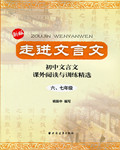题目内容
She dreamed ________ an online bookshop and now her dream is finally realized.
A. openingB. to penC. of openingD. to opening
练习册系列答案
 走进文言文系列答案
走进文言文系列答案
相关题目
题目内容
She dreamed ________ an online bookshop and now her dream is finally realized.
A. openingB. to penC. of openingD. to opening
 走进文言文系列答案
走进文言文系列答案